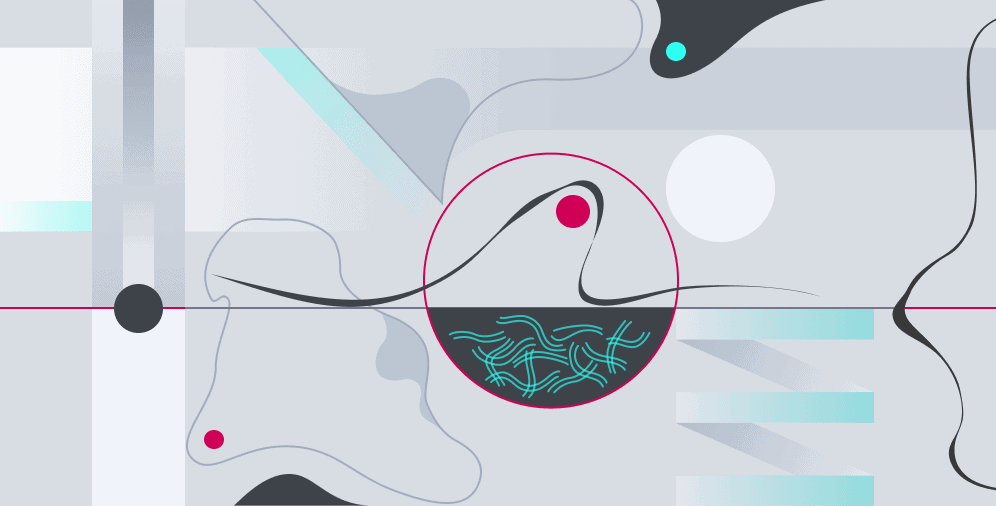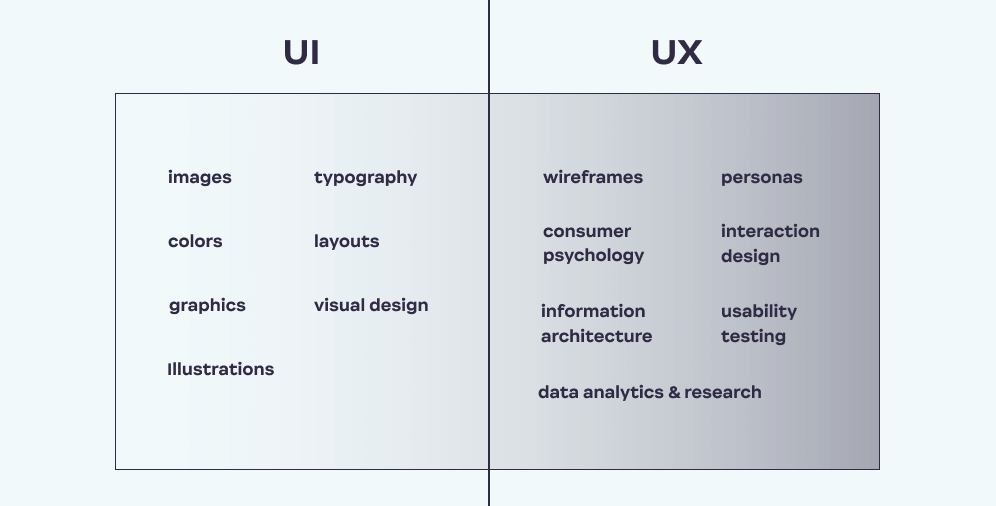Outline:

Do you ever find yourself browsing through websites and forums feeling like you’re trying to decipher something in a foreign language? Do words stop making sense? Do you find yourself doing more googling than actual reading? Does it ever happen with texts on design and web development? We bet it does.
Sometimes it is difficult to get through an article that doesn’t provide any background info as to the terms and the context of the topic. It is time to dispel the darkness with at least one mysterious subject – the difference between UI and UX design. What is UI/UX? If you still think that UI/UX is just some Greek word, possibly concerning food, then this article is for you – Ester Digital will help you with defining a distinction.
What is user experience design
Let’s start with the basics. UX or user experience is pretty self-explanatory: it specifies every action the user has with the product or service. User experience design, in its turn, deals with the mechanics of it – it creates tools and ways of how to make users interact with the product more effectively and successfully.
The UX design concerns a lot of issues: from the texture of the item and how it feels to the skin to the easiness of use on mobile devices. Its main goal is to streamline the process of interaction between users and products or services and make it as accessible and comprehensible for everyone as possible.
UX design not only simplifies the user experience. It has to incorporate various aspects of the company into the process without compromising usability. UX design has to apply methods and tools from different fields – from consumer psychology to market research. Besides the provision of obvious things such as an operating website and a set of useful features, UX design must serve a more wide-reaching purpose – merge several assets of the brand into one seamless experience. Essentially, UX design has to provide this little “something” that users are not even aware of needing.
UX design doesn’t focus on usability as much as it might seem: it’s more about studying users and their needs, values, and possible constraints they may have and integrating them with the business objectives. In other words, UX cares about making the experience of interacting with the product as useful, accessible, and informative as possible.
If you want to find out more about UX design, read our article on how to avoid UX mistakes, or how to carry out a UX audit because very few things can hurt your business performance more than overlooking the importance of UX. Let’s move on to the UI definition now, shall we?
What is user interface design
UI stands for user interface and, as Wikipedia claims, it is the point of interaction between users and machines. In more practical terms, it aims to captivate users by appealing to their visual, kinesthetic, or auditory senses. UI design relies heavily on the aesthetics and the physical and material representation of the product.
Unlike UX, UI doesn’t focus on the “why” rather than “how”. Its main goal is to make the product as appealing and easy-to-use as possible. It doesn’t concentrate on the conceptual aspects as much because it primarily deals with the actual design of the product.
The process of designing user interfaces differs from developing a user experience strategy. UI is more about emotions: it should evoke a pleasurable and enjoyable feel, complement the brand style, be inviting and charming, while carrying out its main task – provide usable and convenient design.
There are myriads of methods and techniques that define what a good interface design should incorporate but the most fundamental and widely used approach is following Gestalt principles. We’ve discussed them in our article on graphic design but it wouldn’t hurt to remind ourselves of them once again.
Gestalt principles help UI designers to understand how users think and how they perceive visual information. There are 6 main rules to follow:
- Principle of proximity: humans tend to group elements together if they are physically close to each other.
- Principle of similarity: we also group things that look similar to each other.
- Principle of continuity: people will see several elements as one if they’re aligned with each other.
- Principle of closure: we will link the elements that have gaps or missing parts.
- Principle of symmetry: if the elements are symmetrical, we will view them as one entity.
- Principle of good figure: people will reduce complex or asymmetrical elements to one or several more recognizable figures.
Since we’ve established both definitions, now it’s time to move to the nitty-gritty of it – the difference between them, how are they important for the business, and why do you even need to know about it.
The difference between UX and UI

After having discussed both terms you might wonder: what is the difference between the two? Do they complement each other or work separately? What is more important for improving your business performance? Why is it crucial to know the distinction?
The thing that is important to understand is that while the concepts depend on each other, they don’t really overlap. Since most design agency ads feature the “UI/UX design” phrase, a lot of people think that it’s a single service. However, the slash sign isn’t there for embellishment: UX and UI designers have specific and separate skill sets and methods they apply in their work.
Simply put, the main difference is in their nature: user experience deals more with functionality and the “hardware”, and user interface relates to the outward appearance of the product. Those are not the only differences and there are a few nuances to take into consideration so let’s delve a bit deeper into it.
#1 UX serves as a foundation, UI inspires to interact
It’s impossible to create any product without thinking about UX. It doesn’t only cover the physical aspects of interacting with a brand such as a layout of a corporate building or the accessibility of your website, but also prevents certain user issues and problems from happening. UX design permeates all the processes of user interaction, and it begins long before the product is even at the nascent stages of its development. Specifically, UX builds out the whole framework, while UI adds its visual and interactive qualities.
#2 UX is focused on the internal journey, UI – on the surface look
An obvious but important distinction that we’ve already discussed earlier. UX puts more focus on conceptual and intangible aspects of the design while UI fleshes them out and turns them into real visual elements and items that can stimulate users to engage.
#3 UI and UX designers have different skillsets and tasks
UX designers usually have more experience in market and consumer research, brand strategy, they apply various analytical methods and approaches, work on wireframes that serve as a skeleton for a future product, and create prototypes that will be used later. UI designers, in their turn, add a tangible dimension to the product by creating high-fidelity mockups following brand guidelines and work extensively with the development team.
Why do we even care about distinguishing the two? As we mentioned earlier, a lot of people think that those two go in the same package. But if you want to get a wholesome product that fully satisfies the needs of your potential customers, you have to know who you need to hire, what are their key responsibilities, and what results you can get from them. If you care about your company, you don’t want to end up with a website that is halfway done or engage professionals that can’t put your vision into practice.
Speaking of professionals – looking for a team that can do both UI and UX design for you? And turn those fancy mockups into an operating website? Contact us and we will deliver a web or mobile solution you’ve been afraid to dream about.
Why do I need UX/UI design
What is it about UI/UX design that makes it so crucial for any design process? The most straightforward answer is this: people are interacting with digital products more and more and it makes them more knowledgeable and picky when it comes to usability and creativity. If the users don’t like the look of the website or find it difficult to navigate through, they will find a better alternative right away and you will lose potential customers and revenue which is detrimental to any business.
Of course, it’s not only this. Encouraging users to stay and engage with your company is vital, but UI/UX helps not only with that. Creative, original, and sophisticated design advances not only its own company but the whole sphere or sometimes even the market. It makes all the players raise their game, constantly challenge themselves, and move the industry further. It also highly increases brand recognition, helps to establish oneself as an independent business community member, and tells your company’s story more effectively.
Look at what we did with Upbeat. A music app with hints of a social media platform, Upbeat is an innovative tool for music lovers. The main task was to create a recognizable yet uncluttered interface and incorporate complex and functional navigation and direct targeting systems into it. UI/UX helped to bring easiness of use and intricate mechanisms together and develop a brand style that can be used further in the development.
Another example of how great UI/UX design helped to improve one’s business performance is Virtuance – a real estate marketing company. We started with a UX audit and used its results to enhance the existing design which was clunky and awkward and didn’t include any interactive tools that could facilitate the process of ordering photoshoots. On top of that, we redesigned the checkout flow, made UI look brighter, and designed a set of marketing materials to ensure that the company is recognized and has a clear and original brand identity. All of that greatly improved their business performance and attracted considerable customer traffic.
As you can see from these two examples, it’s impossible to imagine a website that can draw people in without high-class design and practical tools. More than anything users crave a quick, problem-free, and enjoyable experience and UI/UX is the only thing that can guarantee that.
The difference between web designer and UI/UX designer
Even though you already know practically everything there is to know about UI/UX, one confusing question still remains: how are UI/UX designers different from web designers? Isn’t UI/UX design essentially the same thing as web design? The answer is no – most of the time UI/UX design relates to the work on web platforms but it’s not exclusively about creating websites.
The most basic difference between UI/UX designers and web designers lies in the media they work in. Web designers’ work is focused entirely on the websites. UI/UX encompasses various platforms: mobile apps, desktop programs, physical items, and even spaces. UI/UX exists and can be implemented everywhere which makes it a little bit more flexible.
Web designers deal with more technical stuff than UI/UX designers, sometimes even delving into front end development, since their role is to bring everything together into the final product. They must possess impressive technical skills and programming knowledge in order to achieve that.
UI/UX designers, while undoubtedly having to be skillful and competent, are less restricted by technological limitations. UI/UX designers use technology as a means to improve and simplify the user experience, not for anything else.
However, despite the differences, they serve the same purpose – creating an exceptional product. Our Design Partner Tetiana says: “Both web designers and UI/UX designers have to be well-versed in various spheres and have a wide range of skills – from psychology and market research to web development and A/B testing. It’s hard to overlook the importance of both fields in the creative process. Problem solvers by the nature of their jobs, both web designers and UI/UX designers are truly the superheroes of the digital world.”
Our UI/UX designers are also superheroes (or heroines, to be exact) – they will study your business, examine your needs and requirements, create original and captivating designs, and guide you through the whole process. Don’t hesitate to ask for help – our superheroines will come to the design rescue mission right away!
Also See: How To Hire A UX/UI Designer In 2025: Guide By Ester Digital
On a final note
It’s hard to imagine launching a business without going digital. Any website requires a thorough and skillful design to be a solid player on the market, and that’s not possible without great UI/UX design. While they serve different purposes and functions, the goal is the same: create a product that provides a wholesome, trouble-free, and fun experience for the viewers.
Overstating the importance of both UI and UX is impossible but the main trick here is to work on them together: even though UX is more all-encompassing and “meta”, it isn’t complete without captivating user interfaces, and vice versa.
If you’re unsure about the topic or you’re still at loss about the difference between the two, make sure to contact us and ask us anything you want and more. With vast expertise in design and development, our team will do everything to shed light on any UI/UX-related issue.




